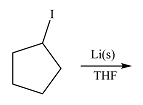
Concept explainers
(a)
Interpretation:
The product of the given reaction is to be predicted.
Concept introduction:
The C atom in the
Answer to Problem 19.1P
The product of the given reaction is

Explanation of Solution
The given reaction is

Magnesium is an active metal and reacts with the polar

Thus, the product of the reaction is phenyl magensium iodide:

The structure of the product was drawn based on reversal of the charge on the carbon atom from the
(b)
Interpretation:
The product of the given reaction is to be predicted.
Concept introduction:
The C atom in the
Answer to Problem 19.1P
The product of the given reaction is
![]()
Explanation of Solution
The given reaction is
![]()
The
![]()
In essence, the reaction inserts the metal atom between the C and Br atoms and leads to a reversal of the charge on the carbon atom.
Thus, the product of the reaction is
![]()
The product of the reaction was drawn based on the reversal of charge on the C atom bonded to bromine.
(c)
Interpretation:
The product of the given reaction is to be predicted.
Concept introduction:
The C atom in the
Answer to Problem 19.1P
The product of the reaction is

Explanation of Solution
The given reaction is

Li is a very active metal and will extract the iodine atom from the substrate. The

Effectively, the reaction results in the replacement of the iodine atom by Li atom, therefore, the product will be

The product of the reaction was drawn based on the reversal of the charge on the carbon atom initially bonded to iodine.
(d)
Interpretation:
The product of the given reaction is to be drawn.
Concept introduction:
The C atom in the
This reverses the initial polarity (charge) of the carbon, allowing it to form a bond with an electron-poor carbon from say a carbonyl carbon.
Answer to Problem 19.1P
The product of the given reaction is

Explanation of Solution
The given reaction is
![]()
The product from part (c) is cyclopentyllithium. Two moles of this compound will react with one of copper(I) iodide to form

The carbon atom in the
The product of the reactio is, therefore,

The product of the reaction was drawn based formation of a bond between the relatively electron-rich carbon atoms and the copper atom.
Want to see more full solutions like this?
Chapter 19 Solutions
Organic Chemistry: Principles And Mechanisms: Study Guide/solutions Manual (second)
- 4. Experimental Procedure. a. How many (total) data plots are to be completed for this experiment? Account for each. b. What information is to be extracted from each data plot?arrow_forwardProvide the IUPAC name of the following molecule. Don't forget to include the proper stereochemistry where appropriate.arrow_forward3. 2. 1. On the graph below, plot the volume of rain in milliliters versus its height in centimeters for the 400 mL beaker. Draw a straight line through the points and label it "400 mL beaker." Volume (mL) 400 350 300 250 200 150 750 mL Florence Volume Versus Height of Water 400 mL beaker 100 50 0 0 2 3 4 5 Height (cm) 6 7 8 9 10 Explain why the data points for the beaker lie roughly on a straight line. What kind of relationship is this? How do you know? (see page 276 text) the design of the beaker is a uniform cylinder the volume of liquid increases evenly with its height resulting in a linear relationship. What volume would you predict for 10.0 cm of water? Explain how you arrived at your answer. Use the data table and the graph to assist you in answering the question. 4. Plot the volume of rain in milliliters versus its height in centimeters for the 250 mL Florence flask on the same graph. Draw a best-fit curve through the points and label it "250 mL Florence flask." oke camearrow_forward
- Show work. Don't give Ai generated solutionarrow_forwardIn the video, we looked at the absorbance of a certain substance and how it varies depending on what wavelength of light we are looking at. Below is a similar scan of a different substance. What color BEST describes how this substance will appear? Absorbance (AU) Violet Blue Green Orange 1.2 1.0- 0.8- 0.6- 0.4- 0.2 0.0 450 500 550 600 650 700 Wavelength (nm) violet indigo blue green yellow orange red Red O Cannot tell from this information In the above graph, what causes -450 nm wavelength of light to have a higher absorbance than light with a -550 nm wavelength? Check all that are true. The distance the light travels is different The different data points are for different substances The concentration is different at different times in the experiment Epsilon (molar absortivity) is different at different wavelengthsarrow_forward5. a. Data were collected for Trial 1 to determine the molar mass of a nonvolatile solid solute when dissolved in cyclo- hexane. Complete the table for the analysis (See Report Sheet). Record calculated values with the correct number of significant figures. B. Freezing Point of Cyclohexane plus Calculation Zone Unknown Solute 2. Mass of cyclohexane (g) 10.14 Part C.4 3. Mass of added solute (g) 0.255 C. Calculations 1. k; for cyclohexane (°C⚫ kg/mol) 20.0 2. Freezing point change, AT, (°C) 3.04 Part C.6 3. Mass of cyclohexane in solution (kg) 4. Moles of solute, total (mol) Show calculation. 5. Mass of solute in solution, total (g) 6. Molar mass of solute (g/mol) Show calculation.arrow_forward
 Organic Chemistry: A Guided InquiryChemistryISBN:9780618974122Author:Andrei StraumanisPublisher:Cengage Learning
Organic Chemistry: A Guided InquiryChemistryISBN:9780618974122Author:Andrei StraumanisPublisher:Cengage Learning
